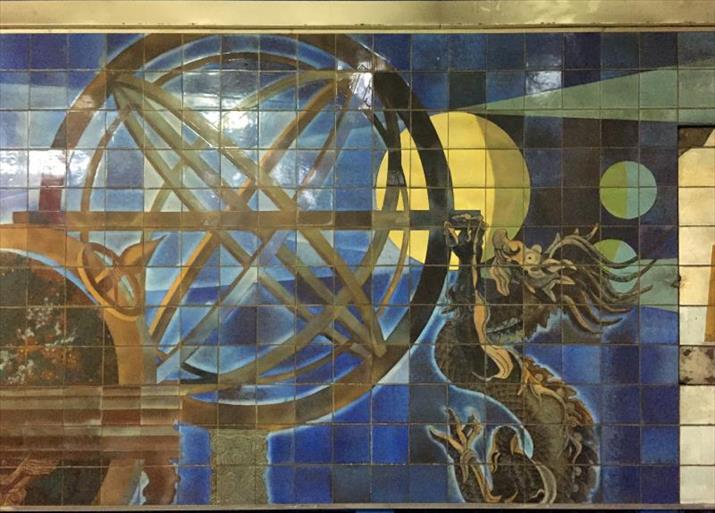| Lifestyle |
| Beijing's Underground Art Gallery | |
|
|
 Part of the mural at the Jianguomen Subway Station in Beijing, which depicts an ancient observatory (BRIAN SALTER)
I was talking to one of my friends recently about a stunning piece of artwork to be found on the Beijing subway. "Oh, you mean there is art there?" she asked incredulously. She said she had never noticed and I have to admit that when you see thousands of people rushing daily past these murals, sculptures, calligraphy, painted columns, or special lighting displays—many of them with their noses stuck in their mobile phones—it makes you wonder why anyone actually bothered to put anything up in the first place. The idea of a subway was first discussed for Beijing in the 1950s. Although the primary aim was to expand the city's transport system, the metro was also seen as something that could be used for civil defense. The most controversial decision of the initial subway lines was the demolition of the capital's historical inner city walls to make way for the subway. Then Premier Zhou Enlai managed to preserve several walls and gates, such as the Qianmen Gate and its arrow tower, by slightly altering the course of the subway. On April 27, 1984, Hu Qili, member of the Secretariat of the Communist Party of China Central Committee, gave an instruction during a visit to the metro that it would be better to provide murals and sculptures to brighten up the stations. The artists could have their names displayed by their works of art. Thus began the presence of art in Beijing's subway system. To start off, three stations on Line 2 had tiled murals applied to the walls of the platforms. One of Xizhimen Station's murals, the 140-meter Yanshan and the Great Wall was made by Zhang Ding in December 1984. Jianguomen's murals were installed in 1985, a year after Xizhimen's. The oldest landmark there is the Beijing Ancient Observatory, which was built in 1442 during the Ming Dynasty (1368-1644), and is the theme of one of the tiled walls in the station. At Dongsishitiao, one of the murals is called Head to the World and is a collage of athletes (made by Li Huaji in April 1985) which alludes to the nearby presence of the Workers' Stadium. However, after over three decades, the murals on Line 2 are slowly falling apart. Not only have the colors darkened with age, but a number of tiles are either broken or missing as a result of the shockwaves caused by faster trains. As the original molds for the murals have been lost, it is now impossible to bake new ones to replace the missing pieces. The six murals of Line 2 were basically how things stayed until the 2008 Beijing Olympics. At that point the city wanted to show itself off to the rest of the world, and as a plethora of new lines and stations were planned, so too was the idea of using artwork to brighten up the stations. You can now find artwork and special design effects at over half of Beijing's 354 stations. But Beijing is currently creating six new fully automated lines which will add yet another 300 km in length to the existing network. My favorites are at Zaoyuan (Daxing Line), Gongzhufen and Chedaogou (Line 10), Jintailu (Line 6) and Huagong (Line 7). But art is a very personal experience; so the next time you travel on the subway, stop staring at your mobile phone and start looking around you. And prepare to be amazed! The author is a British writer and broadcaster living in Beijing Copyedited by Sudeshna Sarkar Comments to yanwei@bjreview.com |
|
||||||||||||||||||||||||||||
|